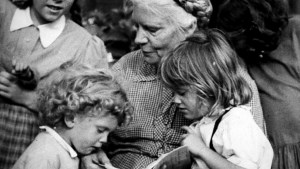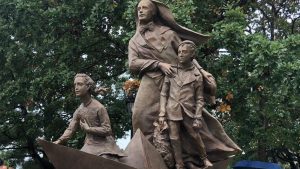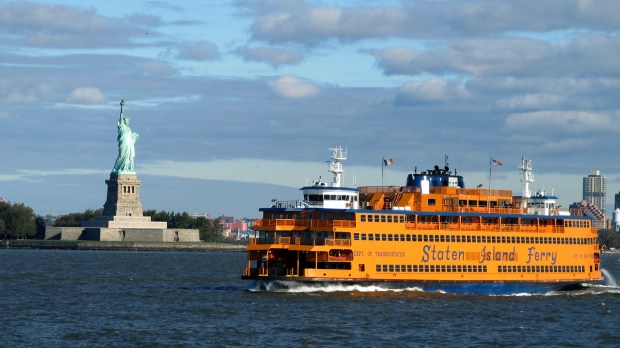Lenten Campaign 2025
This content is free of charge, as are all our articles.
Support us with a donation that is tax-deductible and enable us to continue to reach millions of readers.
For years, The Catholic Worker newspaper maintained its official price per copy of a penny — One Cent.
And for years, New York’s Staten Island Ferry would transport thousands of commuters from Staten Island to Manhattan and back again, charging each passenger just a nickel (today, it’s free).
Now, these two long standing New York institutions will have a convergence of sorts. A new ferry, which should be coming into service some time next year, will be named for Dorothy Day, co-founder of the Catholic Worker movement.
New York City Mayor Bill de Blasio announced Thursday that a new Staten Island Ferry boat will be named to honor Day, a devout Catholic and social activist who spent decades on Staten Island and worked among the city’s poor.
The Dorothy Day is the third #SIFerry named after a woman following boats named for the Revolutionary War Hero Mary Murray & the Staten Island Photographer Alice Austen. #WomensHistoryMonthpic.twitter.com/ypvIeX3sXR
— NYC DOT (@NYC_DOT) March 25, 2021
If Dorothy Day’s cause for canonization advances, the new vessel could one day be the first Staten Island ferry to bear the name of a saint.
“Dorothy Day lived a life of tremendous selflessness and service. I can think of no greater way to honor her beloved legacy than by having her name on this new ferry boat connecting Manhattan and Staten Island,” de Blasio said in a press release. “Day loved Staten Island, and this naming will allow others to learn of her inspiring work as a brave activist and journalist.”
Born in Brooklyn in 1897, Day as a child followed her family to different parts of the U.S. She studied at the University of Illinois, where she became a socialist. Moving to New York, she worked for socialist newspapers and was arrested for marching for women’s suffrage. She also studied nursing in Brooklyn before moving to New Orleans. After a love affair, an abortion and a brief marriage, she bought a cottage on Staten Island with proceeds from a book sale.
In 1925, she fell in love with an anarchist, with whom she had a daughter, Tamar. Though she knew it would lead to the breakup of her relationship with the child’s father, she had Tamar baptized, and she herself, turning her back on her past life, received baptism, at Our Lady Help of Christians Church on Staten Island.
“While covering the 1932 Hunger March in Washington, D.C., for some Catholic magazines, she prayed at the national Shrine of the Immaculate Conception that some way would open up for her to serve the poor and the unemployed,” according to the Dorothy Day Guild. “The following day, back in New York, she met Peter Maurin, a French immigrant and former Christian Brother, who had a vision for a society constructed of Gospel values. Together they founded the Catholic Worker newspaper which spawned a movement of houses of hospitality and farming communes that has been replicated throughout the United States and other countries.”
In addition to her work of offering food and shelter to those in need on Manhattan’s Lower East Side, Day was involved in activism in support of farm workers and against war. In the 1950s, she opened a cooperative farm on Staten Island.
Following her death in 1980, Day was buried at Resurrection Cemetery in the Pleasant Plains section of the borough.
In 2000, then-Archbishop of New York Cardinal John O’Connor introduced Day’s cause for canonization. The Dorothy Day Guild was formed in 2004. In November 2012, after a unanimous voice vote, the United States Conference of Catholic Bishops asked the Holy See to continue the canonization process.
In 2015, Pope Francis cited Day’s inspired leadership alongside Martin Luther King Jr. and Abraham Lincoln during an address he delivered to Congress. In that address, Francis said: “In these times when social concerns are so important, I cannot fail to mention the Servant of God Dorothy Day, who founded the Catholic Worker Movement. … Her social activism, her passion for justice and for the cause of the oppressed were inspired by the Gospel, her faith, and the example of the saints.”
In his statement Thursday, de Blasio said he hopes “every New Yorker can draw inspiration from her legacy.’”
New York City Department of Transportation Commissioner Hank Gutman said there were “so many deserving honorees” to choose from in naming the new boat. “I hope those who petitioned for other names — and who thus may be feeling somewhat disappointed today — will take the time to learn more about Dorothy Day, whose history, example and influence are just so inspiring.”
Also on Thursday, Cardinal Dolan commented, “How providential that the ferry from lower Manhattan to Staten Island should be named after a brave, loving woman who cherished both those areas of our city and the people who live there. How appropriate that a ferry transporting people would honor a believing apostle of peace, justice, and charity who devoted her life to moving people from war to peace, from emptiness to fullness, from isolation to belonging.”
Kate Hennessy, a granddaughter of Dorothy Day and author of Dorothy Day: The World Will Be Saved by Beauty, said, “My grandmother loved Staten Island and treasured her trips on the Staten Island Ferry, the rare time when she could relax and be free of her many responsibilities. While we in her family may find it difficult to line up her selfless work with honors such as this, we nevertheless thank Mayor de Blasio and Staten Islanders for this generous consideration.”
The Dorothy Day is one of three new 4,500-passenger ferry boats built by Eastern Shipbuilding in Panama City, Florida — the first new boats added to the fleet since 2006. The others are the Staff Sergeant Michael H. Ollis, named for a Staten Island resident who was killed in 2013 at the age of 24 while protecting fellow soldiers in Afghanistan, and the Sandy Ground, which honors one of the nation’s first Black settlements — located on Staten Island’s South Shore, which also served as a stop on the Underground Railroad.

Read more:
4 Ways Dorothy Day overcame loneliness — and so can you

Read more:
New York City unveils Mother Cabrini monument

